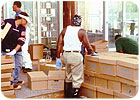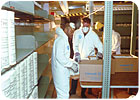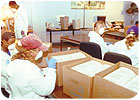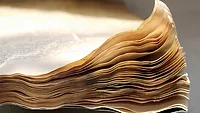Preserving Hurricane-Damaged documents

The New Orleans Notarial Archives maintained a one-of-a-kind collection of documents at its 1340 Poydras St. location – some dating to the 1700s – including slave records and land grants, as well as a letter from Jean Lafitte to Washington, D.C., demanding payment for his expenditures in the Battle of New Orleans during the War of 1812. Many of these documents were recorded on linen.
A few blocks away, inside the basement of the New Orleans Civil District Courthouse in what was originally built as a bomb shelter during the Cold War, the Archives maintained an equally large collection of documents. Sixty thousand leather-bound volumes were stored on metal shelves, containing the records of all property transfers in New Orleans in the modern era.
In August 2005, Hurricane Katrina made landfall in New Orleans.
Most governments have digitized their records, but at the courthouse basement archive, abstractors still do hand searches. Without access to the Notarial Archives, no one in New Orleans can buy or sell property, and many insurance claims cannot be settled.
“A typical day would include 20 to 30 people poring through the brown leather books, tracing the history of individual land parcels, confirming the validity of titles or recording land purchases,” said Stephen P. Bruno, New Orleans custodian of historical records.
Bruno was just about to hire a firm to transfer many of the 12 million documents stored in the Archives to computer when Katrina hit. Yet Bruno was prepared for natural calamities. The Notarial Archives was registered with Munters Moisture Control Services Code Blue Program. Soon after Katrina, Archive executives learned that MCS personnel and equipment were already stationed outside the city and ready to respond.

“The city was under a state of martial law, and we could not gain entry,” Eddy Pokluda, MCS national business development manager and Notarial Archives project coordinator, said. “This was frustrating, because there’s a short amount of time before water damage documents can be saved.”
Bruno arranged an emergency travel authorization that gave Archive officials and Munters personnel security clearance into New Orleans. Munters immediately launched its restoration effort, dispatching equipment and personnel to both Archive locations. Performing operations swiftly and efficiently was imperative to minimize further damage to the documents.
“When paper gets wet, paper fibers start to swell, and they cockle,” Pokluda said. “Ink may run, mold may grow, and degradation begins, but freezing halts any further damage.”
Removing bacteria-laden, snake-infested standing water was priority No.1. MCS brought in generators to operate pumps, and crews spent 36 consecutive hours extracting thousands of gallons of water. A reptile expert was brought in to remove the snakes from the courthouse basement.
With the water removed, 60-person crews began removing the 60,000 volumes from the basement. The books were hand-carried out, loaded into boxes, inventoried and placed on pallets. The pallets were then lifted by forklift into an MCS freezer truck. Once inside, the documents became frozen, eliminating any further damage due to the liquid phase of water.
At the 1340 Poydras St. location, a new hurdle arose. The building’s owner, citing liability concerns, denied access to the building. Bruno signed a waiver of liability and assumption of risk documents stating that the risks were small and emphasizing the need to save the city’s historical records.
With approval to enter, the MCS crews went to work to control the ambient conditions inside to reduce the chance of mold growth or deterioration. Broken windows were boarded up, with a conduit being created through one to allow desiccant dehumidification equipment to pump dry air inside. As the process was being completed, wet documents were being removed and packed in trailers.
It took 10 days to remove the 60,000 volumes from the courthouse basement, and two days to remove damaged volumes from 1340 Poydras St. All told, the materials filled 3 freezer trailers. The work was conducted under the auspices of a citywide curfew, checkpoint delays, fuel shortages, road blockages, flooding, no electricity, and a lack of food and water.

The Drying Process
Once a trailer was filled, it was driven to company’s Glendale Heights, Ill., facility. There, the company’s accelerated vacuum freeze dry system treated the damaged paper.The method involved placing materials in an airtight chamber into which a deep vacuum pressure is induced. As a function of physics, frozen moisture in the materials is sublimated, going from a solid to a gas without becoming liquid.
“It is moisture in a liquid state that does most damage to materials,” Pokluda said. “Therefore, the freeze dry method is the optimal method for drying a wide range of materials while keeping damage to a minimum.”
Once the drying was complete, the documents underwent cleaning and decontamination. Because of the nature of the dirty water, and the fact that the documents would later be handled, part of the cleaning process included putting the documents through gamma radiation.
“The documents were saturated with black water, which oftentimes is polluted with E. coli and other unsafe contaminants,” Pokluda said. “The use of gamma radiation eliminates any bacteria or other micro-organisms.”

“We are happy to report that we didn’t lose one page of the 60,000 notarial volumes housed in the basement,” Bruno said. “There was only minimal damage to some of the books due to dirt, but that was expected.”
The Archives plans to move the entire collection to the fifth floor of the 1340 Poydras St. location. If you liked this feature circle 139 on page 51.
Looking for a reprint of this article?
From high-res PDFs to custom plaques, order your copy today!



